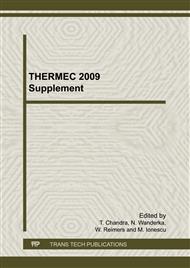p.73
p.79
p.85
p.91
p.97
p.102
p.107
p.112
p.118
Mechanical Behaviors of Nanoimprinted Cu-Ni Alloys Using Molecular Dynamics Simulation
Abstract:
Molecular dynamics (MD) simulation with a tight-binding potential is used to studied the mechanical behaviors of nanoimprinted Cu-Ni alloys before and after annealing. The annealing process consists of three different stages. Initially, there is a gradual heating from the original temperature of 300 K to the specified annealing temperature of 823 K and then it is followed by a period of constant heating at that temperature, after which the specimen temperature is allowed to cool gradually to the original temperature. The results showed that when the punch is advancing, the punching force obtained from the simulation with a tight-binding potential is lower than with the Morse potential. The internal energy of Cu-Ni alloys decreased with increasing the temperature and the component of Cu during the annealing process. In addition, comparing the residual stress in the Cu-Ni alloys with and without annealing treatment, the stress is significantly released after annealing.
Info:
Periodical:
Pages:
97-101
Citation:
Online since:
January 2010
Authors:
Keywords:
Price:
Сopyright:
© 2010 Trans Tech Publications Ltd. All Rights Reserved
Share:
Citation:


